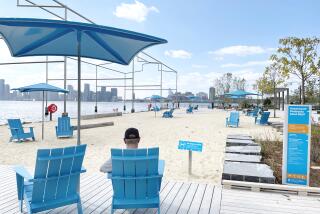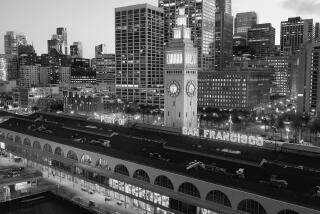Ferryboats Make a Comeback on the Waters of New York
- Share via
NEW YORK — Ferryboats, a transportation tradition from the time Dutch settlers colonized New Amsterdam in 1624, are making a comeback 20 years after the last private line stopped plying New York City’s waters.
Ten new ferry routes carrying more than 4,000 commuters daily between Manhattan and Brooklyn, Queens and New Jersey have sprung up in the last year as stifling congestion on the city’s subways, bridges and tunnels grows worse.
In addition, the city is cleaning up, repairing and improving service on the Metropolital Transit Authority’s Staten Island ferry, which was established in 1755 and carries 80,000 people a day for 25 cents round-trip across New York Harbor, the best buy in town.
New York will never be another Venice--the number of people riding ferries is minuscule contrasted with the 5.4 million daily bus and subway riders--but city officials are counting on boats to play a major transportation role in the next decade.
‘The Only Open Space’
“There’s nothing at all floating on the Hudson River now,” says Sigurd Grava, an urban planning professor at Columbia University. “There’s no reason you can’t put as many vehicles as you want out there. It’s the only open space we’ve got left in the city.”
Since the first new line opened in July 1986, there has been a flurry of ferry activity in New York:
- Ten routes operated by three private companies carry commuters to Manhattan, a ferry runs from Wall Street to LaGuardia Airport and several other lines are awaiting city approval.
- The Port Authority of New York and New Jersey has announced plans for a $150-million mass-transit ferry operation from Hoboken, N.J., to Battery Park, beginning in 1990, which would link up with subway lines on both sides of the river.
- The New York City Planning Commission is studying the feasibility of water taxi service from 60th Street on Manhattan’s West Side around the southern tip of the island and up to East 60th Street.
- The city’s Bureau of Transit Operations has received $60,000 in federal aid to develop potential ferry routes and docking sites.
City officials envision 400-foot catamarans and hydrofoils cruising around the five boroughs, Long Island, New Jersey and Upstate New York, carrying commuters, tourists, prisoners, police officers and firefighters.
“We could use the ferries for runs during commuting hours and then look to use them for other sorts of city business,” says Henry F. White Jr., deputy commissioner of the Bureau of Transit Operations. “It goes from hospitals to corrections to fire to sanitation--getting people here and there.”
300-Year-Old Tradition Revived
The ferries revive a tradition more than 300 years old of canoes, sailboats and steamboats cruising the region. The first ferry license was granted in 1661 for a route from Communipaw, now Jersey City, N.J., across the Hudson River.
Dutch settlers established regular service from Brooklyn to lower Manhattan in the early 1700s. Ferries powered by horses walking on treadmills were popular later that century, and Robert Fulton introduced steamboat service across the Hudson River in 1810.
“There are stories of a horn being hung on a tree that you’d blow and the ferryman would come over,” says Kevin Tremble, a Port Authority engineer who has researched ferry history. “You would pay for the privilege of manning the oars.”
“It was steam power that brought the ferry into its own as a reliable means of transportation,” Tremble adds. “Steam really opened Manhattan up to the rest of the world in the early 19th Century.”
By 1900, railroad terminals lined the New Jersey waterfront, operating about 15 ferry lines to New York City. In 1920, ferries made 2,000 daily trips across the Hudson River, moving 260,000 passengers and 12,000 vehicles a day.
Ferries were so popular that a songwriter named E. Di Lazzare composed the “Ferry-Boat Serenade.” Walt Whitman, who rode the Brooklyn boats for 15 years, romantically wrote in 1882: “I have always had a passion for ferries; to me they afford inimitable, streaming, never-failing, living poems.”
But the advent of passenger cars, highways and subways, and the decline of the railroads, gradually killed the ferries. The New Jersey PATH subway opened in 1908, the Pennsylvania Station rail tunnel in 1910, the Holland Tunnel in 1927, the George Washington Bridge in 1931 and the Lincoln Tunnel in 1937.
Decline Started in ‘30s
“(Ferry service) was really starting to decline in the 1930s, and it never recovered,” Tremble says. “The railroads were never able to refurbish their systems, and the habits of the public changed.”
By 1940 there were 10 Hudson ferries and one East River run--down from a total of 30 at the turn of the century. In 1950, there were six lines, and 10 years later just three. The last ferry crossed from Hoboken on Nov. 22, 1967.
Now transit officials say the roads, bridges and subways are saturated. Commuter travel across the Hudson has grown more than 25% since 1980, and another 20% increase is forecast by 1990.
Manhattan’s central business district gained more than 200,000 new jobs in 1977-85, according to a Port Authority report, and is still expanding. At the same time, New Jersey has become the region’s fastest-growing housing market, and developers want to build 27 million square feet of new waterfront office space there.
So with hourlong traffic tie-ups not unusual and the New York subway system carrying the most people since 1974--3.7 million daily in May--the ferry is a born-again idea.
“We have an area where the road system is being used very heavily, and on top of that, all this development is occurring,” says Herman Volk, director of New Jersey’s Waterfront Development Office.
“There’s a need to provide more capacity across the river, and no one system is going to produce the answer,” he says. “Ferries provide a relief.”
An oil industry slump has created a supply of old crew boats used for Gulf of Mexico oil rigs. A city official said the boats cost $100,000 to $200,000 and need another $600,000 of work to be converted into commuter ferries.
The private ferry lines are gaining passengers daily and experimenting with routes; four lines have been tried and failed. Trips range from the three-minute runs straight across the Hudson or from Wall Street to Brooklyn, to a 55-minute voyage from lower Manhattan to Highlands, N.J., that costs $19.50 round-trip. About 400 people a day ride that boat.
Passengers--mostly middle- and upper-income business people--say the ferries cost about the same as taking a private bus line or driving to work and can save up to an hour on commuting.
More to Read
Sign up for Essential California
The most important California stories and recommendations in your inbox every morning.
You may occasionally receive promotional content from the Los Angeles Times.










